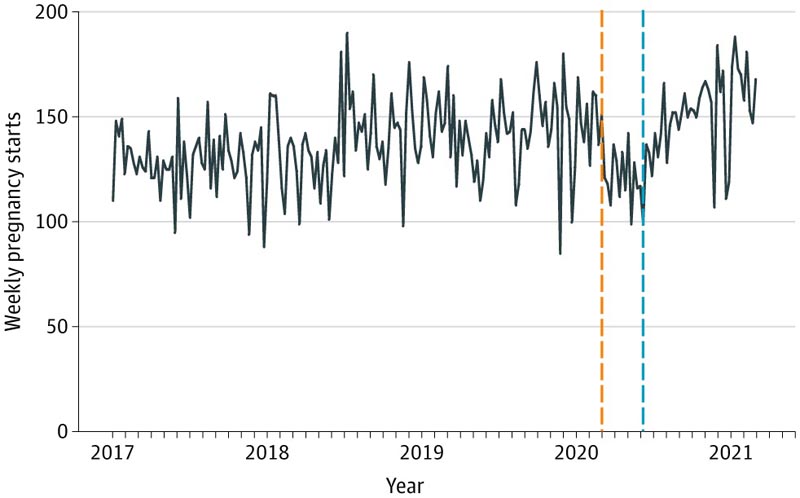Key points Can electronic health care records be used to monitor and project changes in pregnancy and birth rates following societal shutdowns from the COVID-19 pandemic? Findings In this pregnancy cohort study within a large US university healthcare system, a model using electronic medical records (used retrospectively from 2017 and modeled prospectively through 2021) projected an initial decline in births associated with COVID-19 pandemic social shutdown, predominantly related to fewer conceptions following social changes instituted to control the spread of COVID-19. This decline was followed by an increase in projected birth volume expected to occur in summer 2021. Meaning These findings suggest that electronic health records can be used to model and project changes in birth volume and demonstrate that COVID-19 pandemic social changes are associated with reproductive choices. |
Importance
The influence of the COVID-19 pandemic on fertility rates has been suggested by the lay press and anticipated based on documented declines in fertility and pregnancy rates during previous major social and economic changes.
Advance planning for birth rates is important for healthcare systems and government agencies to accurately estimate the size of the economy and model the working and/or aging population.
Aim
To use projection models based on electronic health care records at a large US university medical center to estimate changes in pregnancy and birth rates before and after COVID-19 pandemic social closures.
Design, environment and participants
This cohort study included all pregnancy episodes within a single US academic healthcare system retrospectively from 2017 and modeled prospectively through 2021. Data were analyzed in September 2021.
Exhibitions
Society closure measures before and after the COVID-19 pandemic.
Main results and measures
The primary outcome was the number of new pregnancy episodes initiated within the health care system and the use of those episodes to project birth volume. Interrupted time series analysis was used to assess the degree to which COVID-19 social changes may have influenced the volume of pregnancy episodes.
Possible reasons for changes in volumes were compared to historical pregnancy volumes, including delays in the initiation of prenatal care, interruptions in reproductive endocrinology and infertility services, and preterm birth rates.
Results
This cohort study documented an increasing number of pregnancy episodes during the study period, from 4,100 pregnancies in 2017 to 4,620 in 2020 (28,284 total pregnancies; median maternal age [interquartile range], 30 [27-34 ] years; 18728 [66.2%] White women, 3794 [13.4%] Black women; 2177 [7.7%] Asian women).
A 14% reduction in the onset of the pregnancy episode was observed after the social shutdown of the COVID-19 pandemic (hazard ratio, 0.86; 95% CI, 0.79-0.92; P < 0.001) . This decline appeared to be due to a decline in beliefs that followed the COVID-19 pandemic shutdown ordered on March 15.
Prospective pregnancy modeling currently suggests that an increase in birth volume can be anticipated in summer 2021.

Trajectory of weekly volumes of new pregnancy episodes from 2017 to March 2021 . The orange vertical dashed line indicates when the state-mandated stay-at-home order was implemented and the blue dashed line marks when the stay-at-home order was lifted .
Conclusions and relevance
This cohort study using electronic health record surveillance found an initial decline in births associated with COVID-19 pandemic social changes and an anticipated increase in birth volume.
Future studies can further explore how changes in the volume of pregnancy episodes can be monitored and how birth rates can be projected in real time during major social events.
Comments
Michigan Medicine - University of Michigan ANN ARBOR, Michigan
A different kind of surge may be on the way more than a year into the pandemic: a baby surge.
The COVID-19 shutdown initially appeared to put a pause on pregnancy and birth rates, new research from a major hospital system suggests, but that trend is quickly reversing.
"Birth rates declined early in the pandemic, but we expect a dramatic rebound soon," says lead author Molly Stout, MD, MSci, director of maternal-fetal medicine at Michigan Medicine Von Voigtlander Women’s Hospital.
"We’re already seeing signs of a summer baby surge."
While infectious disease experts have been modeling COVID cases to project surge trends, Stout and her team have been doing the same with pregnancy trends.
Using electronic health records for a pregnancy cohort at Michigan Medicine, researchers were able to model pregnancy episodes and accurately project anticipated changes in pregnancy volumes over the past year during pandemic societal changes.
Pregnancies at UM gradually increased between 2017 and 2020, from 4,100 pregnancies to 4,620 a year, according to the study in JAMA Network Open . But pregnancy volumes diverged from that pattern, declining by about 14% between November 2020 and spring 2021, which researchers associate with a conception window beginning during the US COVID shutdown in March. of 2020.
Experts point to multiple potential factors for the decline, including economic uncertainty, lack of regular child care or support systems, the impact on women in the workforce, and the deferral of reproductive and fertility care.
Based on the same modeling system, the authors now anticipate a surge in births. The hospital plans a 10-15% increase in births over what would normally be expected in the summer and fall of 2021.
While speculation about a COVID baby boom had previously been reported in the media, it was mostly speculative and not based on data, Stout says.
"What we have shown here is that through modeling pregnancies within a health system we can project birth rate increases and decreases associated with important social changes," he says.
"Major social changes certainly seem to influence reproductive choices, population growth, and fertility rates. We typically see the effects when modeling birth and death rates, only when the changes are occurring. With this methodology we can accurately project anticipated birth rates ahead of actual changes."
This has also been observed at other times in history, such as the H1N1 influenza pandemic of 1918, the Great Depression in 1929, and the 2008 recession.
Stout says the ability to predict upcoming birth trends through the Michigan team’s modeling system can help health systems better plan for labor and delivery needs to provide the safest care for patients. and their babies.
"These projection techniques can inform capacity planning, staffing needs, and other downstream effects on the hospital system," he says.
"But it can also be used in partnerships between hospitals and government groups to better understand population dynamics and help minimize the negative effects of a pandemic or any other major event on society."
















